Day 3 of a three day tour in the Brecks and North Norfolk today. It was originally forecast to rain all morning but instead it stayed dry – although cloudy most of the day it was generally bright with a nice sunny spell either side of midday, and although there were some very dark clouds later afternoon thankfully they passed overhead without producing any rain. It was rather breezy again, with a fresh southerly wind. We spent the day in North Norfolk today.
Our destination for the morning was Holkham. We parked at Lady Anne’s Drive and got out to scan the grazing marshes, which are still full of birds. There were lots of ducks around the pools – Wigeon, Shoveler, Teal and a few Gadwall. Further back, several hundred Pink-footed Geese were mostly sitting down in the grass at the back but we got the scope on a couple which were standing up. We could see their pink legs, if not their feet!
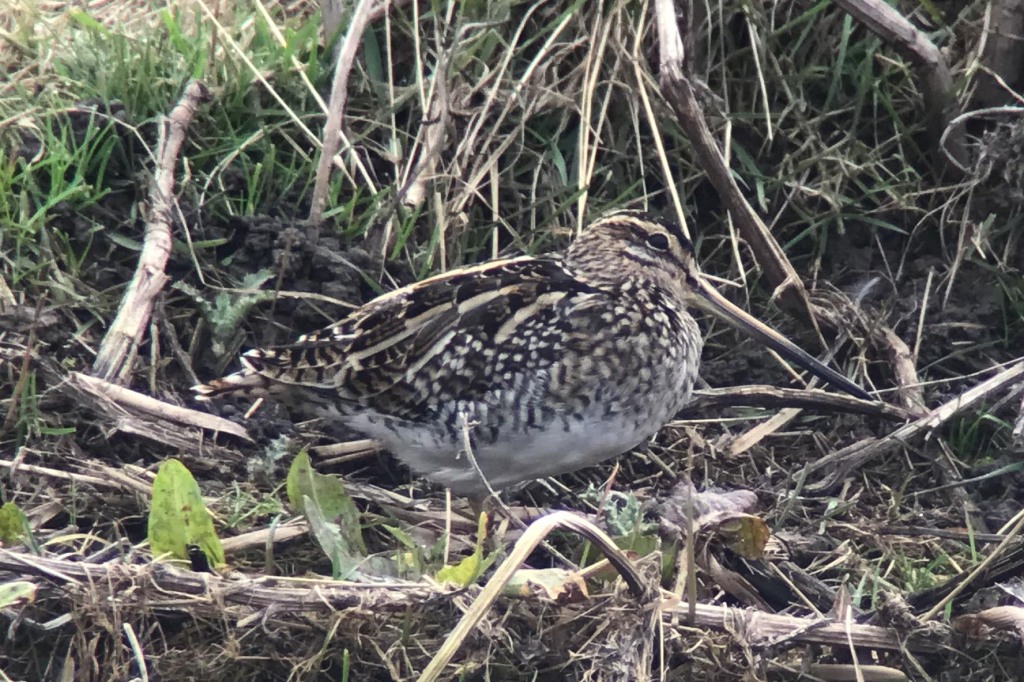
There were waders too. We trained the scopes on several Common Snipe roosting on a small bank, and further up we found lots hiding among the molehills. There were Redshank around the pools and a few Curlew and Oystercatchers out on the grass. A large flock of Black-tailed Godwits and Dunlin flushed from the marshes further to the west and whirled round in the sky.
Several raptors were up enjoying the wind. Occasionally a Marsh Harrier would buzz the marshes, flushing all the ducks. Several Red Kites and Common Buzzards circled up too. We couldn’t see the Grey Partridge in their usual spot this morning, but we figured they would be hiding somewhere out of the wind, which was gusting in across the open marshes. We made our way on and out over the boardwalk towards the beach.
There seemed to be a few birds on the move today – a small flock of Chaffinches whirled over the north edge of the pines and a small flock of Starlings and then seven Fieldfares came in over the beach.
The Shorelarks had been feeding on the saltmarsh west of the Gap the last couple of days, so we walked out that way first. There were lots of Meadow Pipits on the edge of the dunes which flew up ahead of us as we walked west, as well as several Skylarks. A passing dog walker told us that he had seen the Shorelarks along the southern edge of the saltmarsh but there was no sign of them over that side – we weren’t sure whether he was just winding us up or mistaken. We assumed they had gone back to the cordoned-off area further east today. We continued on west.
We stopped to scan the sea and could see lots of Common Scoter scattered over the sea beyond the beach. We had a look through, but couldn’t see anything with them at first. There were a couple of Ringed Plover out on the beach.
We found another small flock of scoter offshore further west and this time we could just make out 2-3 Velvet Scoter in with about twenty Commons. They were diving constantly and distant, but we could see the Velvet Scoters were a little bigger, with smaller, more contrasting white spots on the face. Occasionally one flapped and showed off the white in its wings.
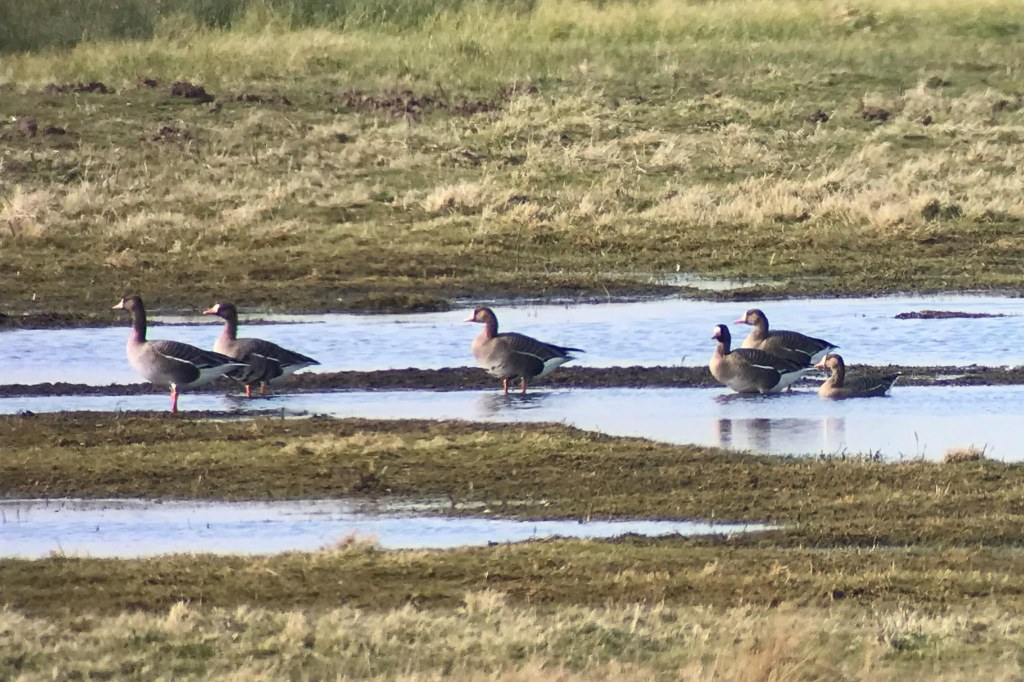
We cut through the dunes and pines to Joe Jordan hide. Down on the grass below, we could see several groups of White-fronted Geese, but we were looking into the sun. Another twenty or so were a bit more distant around the pools to the west of the hide but were perfectly lit – showing off their white blazes around their pink bills and distinctive black belly bars.
A Great White Egret flew in over the grass and flushed another from one of the ditches, the two of them flying across the old fort with exaggerated deep wingbeats. They landed separately on the marshes where we could get them in the scope and have a better look. There were a few Avocets out on the pools here too.
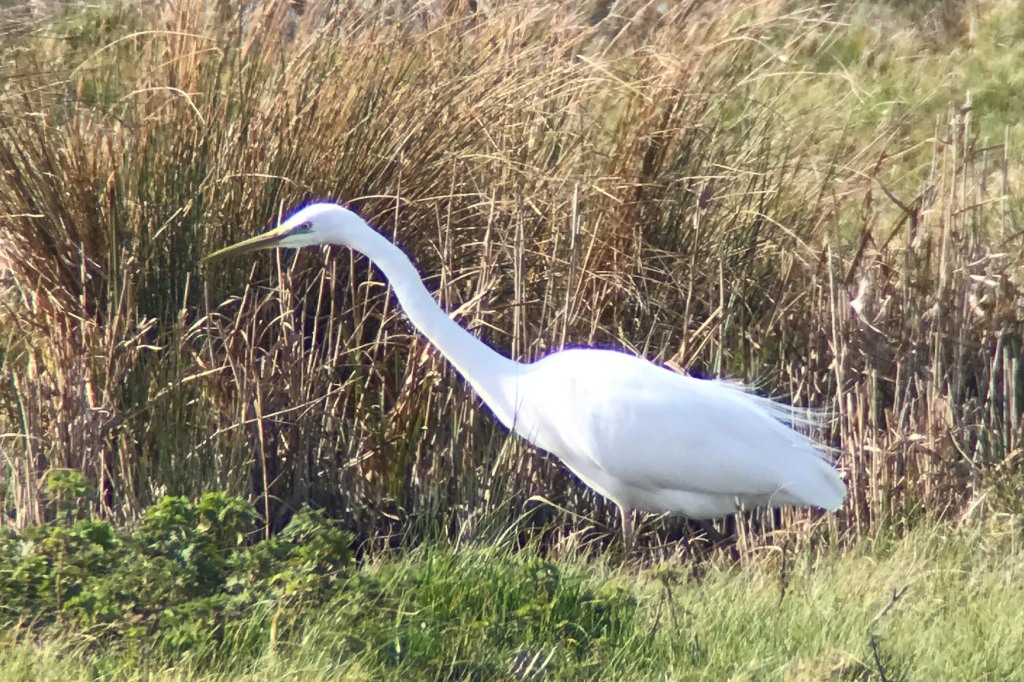
The big white bird we were really hoping to catch up with here was Spoonbill, as the first birds have already returned to the breeding colony. At first, we just saw one or two fly up and round over the trees at the back and got the scope on a white shape perched deep in the branches.
Then one Spoonbill flew out of the trees and dropped down onto the pool in front of the hide, where it proceeded to start feeding, walking around in the shallow water sweeping its bill from side to side and occasionally snapping it upwards when it caught something. We could see the yellow tip to its bill, its shaggy nuchal crest and mustard wash on its white breast, all indicating an adult coming into breeding condition.
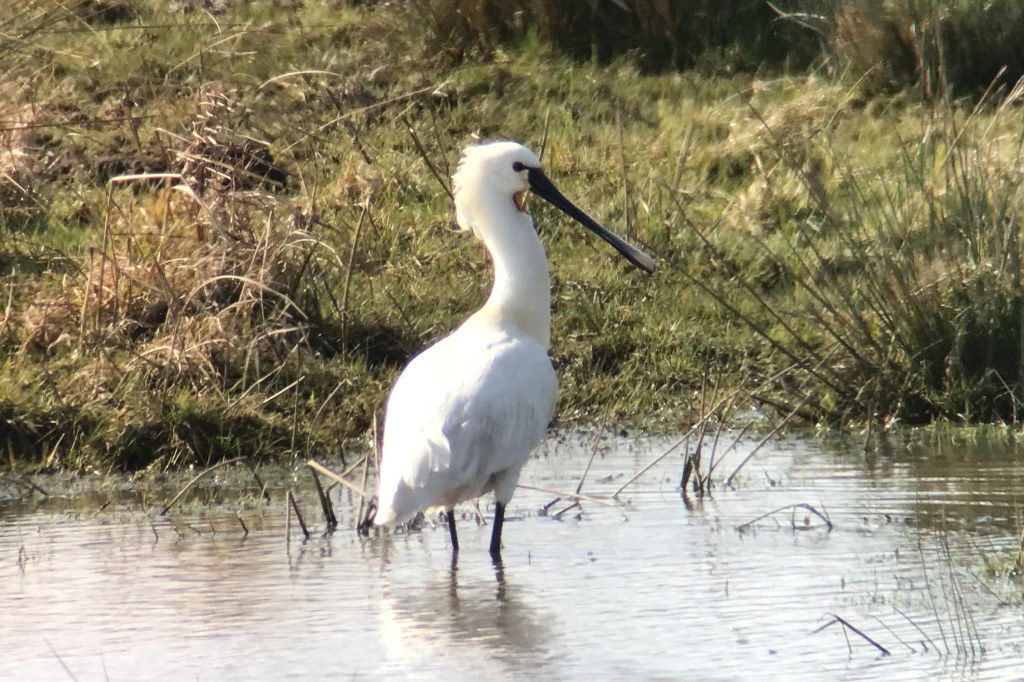
Some other people arrived so we decided to free up space in the hide and walk back. There were several Chiffchaffs singing in the trees by the track and we stopped to watch one flitted around in the branches. A Peacock butterfly flew up from the edge of the track past us. The sun was out now and it felt distinctly spring-like out of the wind.
We stopped briefly at Salts Hole. A Peregrine drifted east along the edge of the pines. A single Little Grebe appeared out of the reeds. We got the scopes on a couple of Fieldfare in the grass at the back and a pair of Mistle Thrushes, one of which posed on a fence post.
Sure enough, we had a message to say the Shorelarks were indeed back in the cordon. After a brief stop at The Lookout, we set off for a quick walk down to look for them. When we arrived, there was no sign out in the middle where they had apparently been a few minutes earlier but scanning across we realised they were on the edge, right by the path out to the beach.
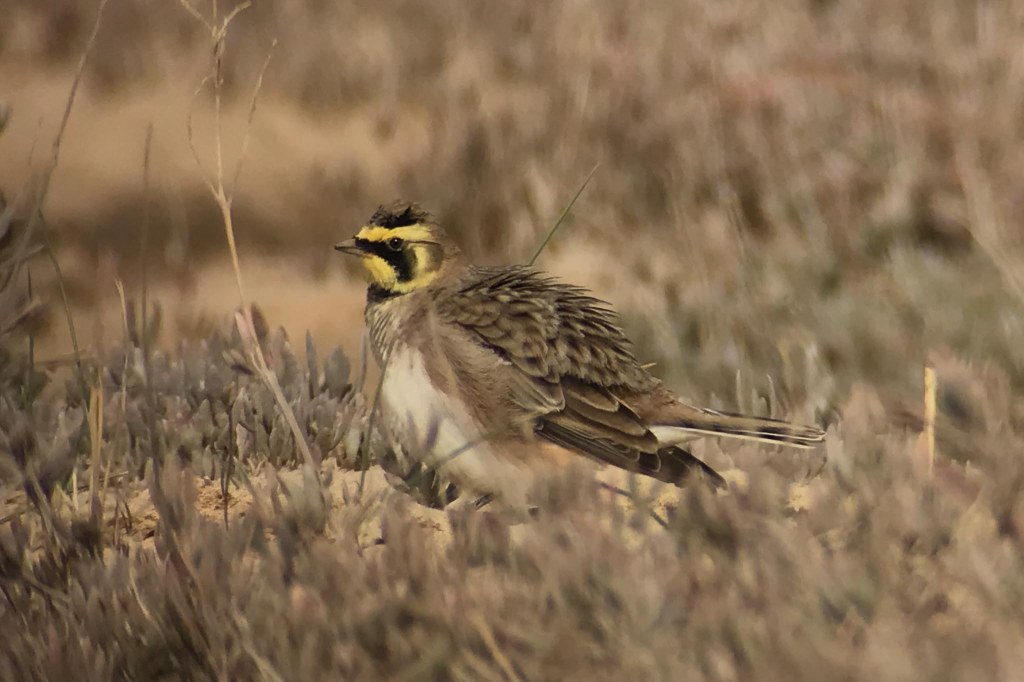
We walked a little further towards them and set up the scopes. The Shorelarks were ‘dust’ bathing in the bare sandy patches just beyond the fence, which was great to watch. Afterwards, they stood up in the top of the low dunes to shake off and preen. We had great views of them now, their yellow faces perfectly lit in the sunshine. Stunning!
The Shorelarks gradually worked their way further back away from us and then took off and flew down to the very far end of the cordon. They may not be with us for too much longer now, before they head back up to Scandinavia for the breeding season, so it was good to catch up with them. Having enjoyed great views, we set off back for lunch.
We stopped for lunch at the picnic tables outside The Lookout. Looking down from a different angle from here, we could see the pair of Grey Partridges now, hunkered down in the lee of the molehills where they weren’t visible from the Drive. After lunch, they had come out a bit more and we watched them as they fed in the grass.
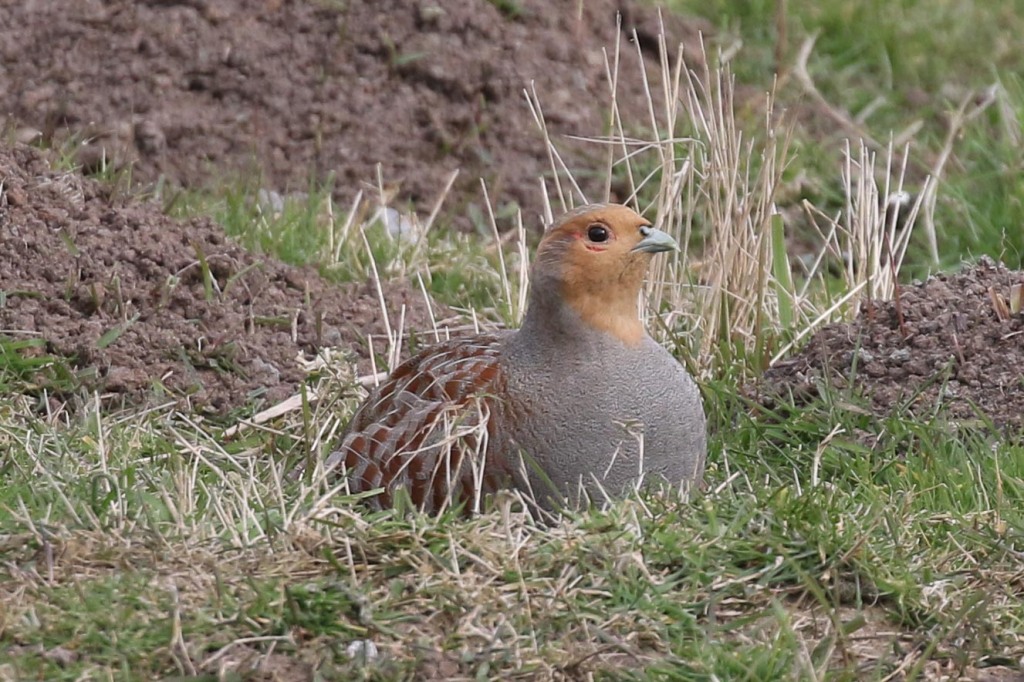
The Red-breasted Goose had reappeared this morning in the Eye Field at Cley, where we had failed to find it yesterday afternoon. We decided to have another go and as we pulled up in the beach car park we had spotted it out with the Brent Geese right in front of us before we even had a chance to get out of the minibus! There were noticeably more Brents here than there had been yesterday.
We got out and got the scopes on the Red-breasted Goose. It had its head down at first, feeding, and was harder to pick out although blacker than the Brents with more white stripes on its wings. Occasionally it stopped and lifted its head, calling. We could hear the Red-breasted Goose’s distinctive squeaky call above the subdued chattering of the Brents.
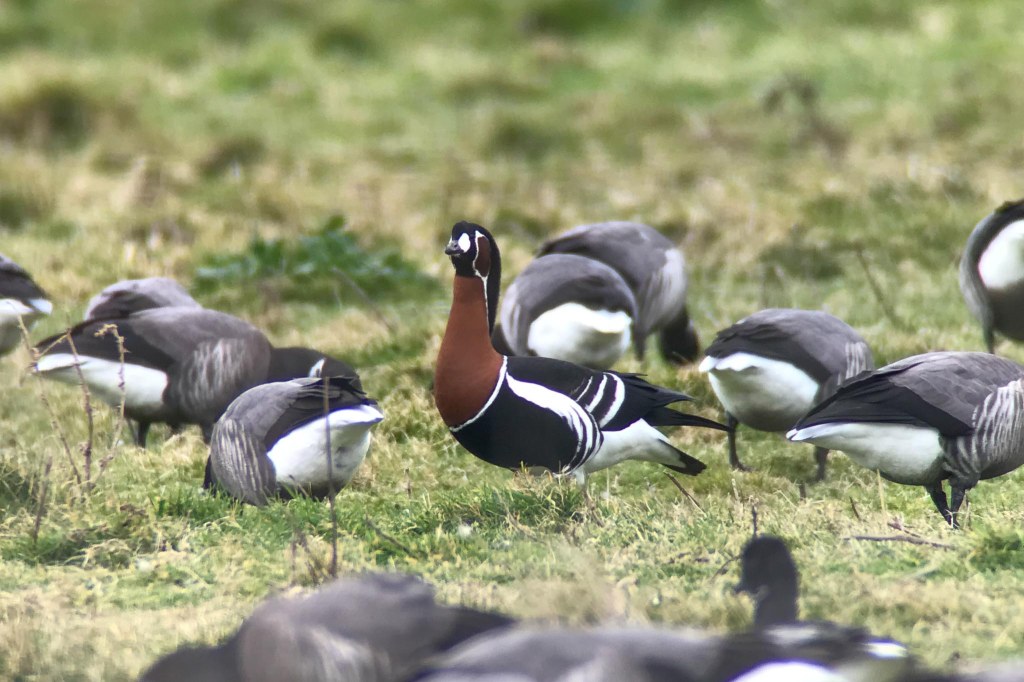
There was a single Pale-bellied Brent in with the regular Dark-bellied Brents too strikingly paler on the flanks. We had planned to spend the afternoon at Titchwell, but it was well worth the diversion over here to see the Red-breasted Goose. We still had a bit of time left, so we decided to make a quick dash back west.
It was nice and sheltered in the trees at Titchwell. We had a quick look for the Water Rail but we couldn’t find it in the ditches today. Once we got out of the trees, we were back out into the wind but it seemed to have dropped a little. Coot was an addition to the trip list in one of the channels and there were a few Tufted Duck and a single Common Pochard out on the reedbed pool.
We stopped in Island Hide, where several Avocets were busy feeding in front of the hide and a Common Snipe flew off from right below us and landed on the edge of the reeds with a couple of others. A Turnstone flew in and landed on the edge of the nearest island and a large flock of Dunlin whirled round before landing over in front of Parrinder Hide. A few Black-tailed Godwits were busy probing in the grass at the back, on the old Avocet Island.
There were lots of gulls on one of the islands and we quickly got the scopes on several adult Mediterranean Gulls in with the commoner Black-headed Gulls. They are looking very smart now, with their jet black hoods and contrasting white eyeliner, deep red bills and white wingtips. We could hear their yelping calls too.
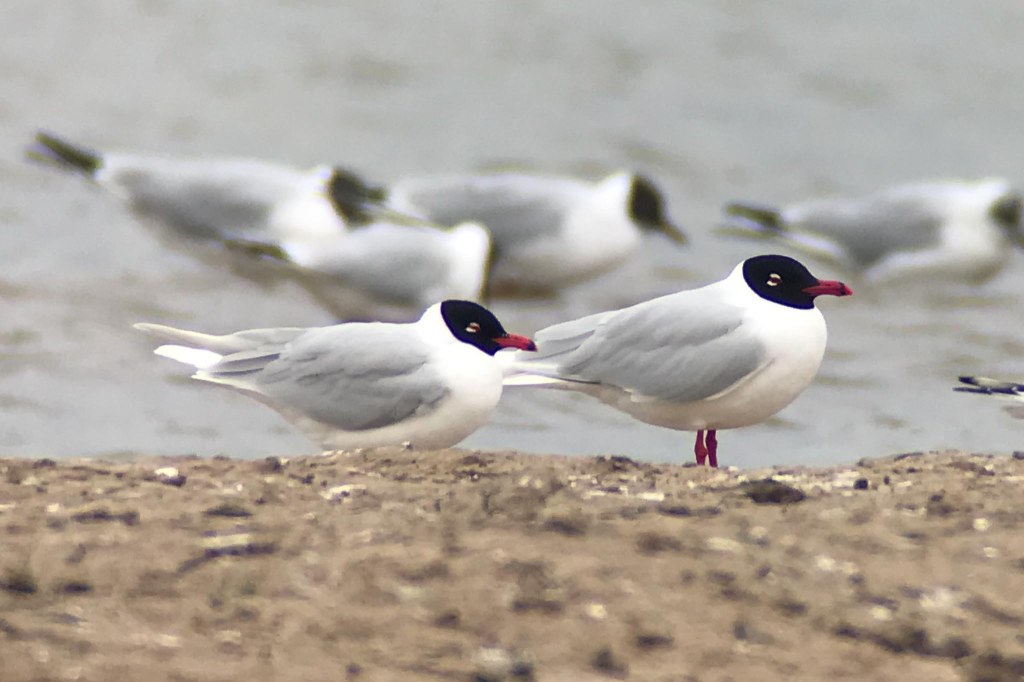
A smart pair of Teal were dabbling right in front of the hide too and a few more Common Pochard were diving out beyond the islands. We really wanted to try to get out to the beach quickly, so we made our way back out to the main path. We could hear Bearded Tits calling in the reeds but couldn’t see them – they were staying well down in the breeze. A lone Grey Plover was on the Lavendar Marsh Pool opposite.
There were just a few Redshank and Curlew on Volunteer Marsh but we stopped at the Tidal Pools to look at a pair of Red-breasted Merganser diving out in the middle. The drake was looking very smart with its punk haircut. We could see dark clouds approaching from behind us now and rain falling away to the west, so we hurried out to the beach, fearing the worst.
There was a nice selection of waders out on the beach. Several Bar-tailed Godwits were feeding along the shoreline and small groups of silvery Sanderling were running in and out of the waves as they broke on the sand. There were more Grey Plover and Oystercatchers here too. A single Great Crested Grebe was asleep on the sea just beyond the breakers.
Unfortunately, we were out of time. We made our way back, as the dark clouds thankfully passed overhead without dropping any rain on us and we made it back to the car park dry. A whistlestop visit to Titchwell, but a nice way to round off the day and the tour.
















